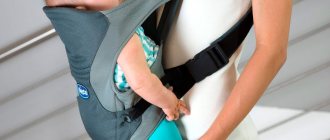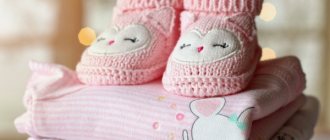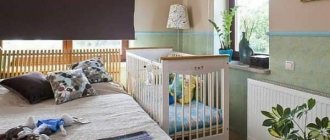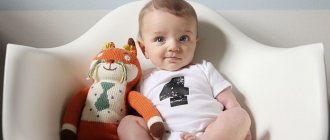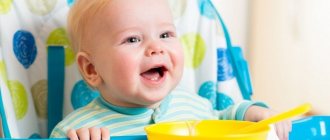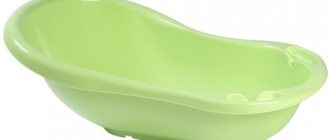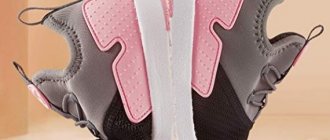A variety of baby carriers are very popular. They are comfortable, take up little space compared to a stroller and leave the mother's hands free. One of the first such devices to appear was the kangaroo backpack. Before using it, parents need to know from how many months and for how long they can carry a child using this design.
- 2 When can you carry a baby in a kangaroo?
- 3 Safety for boys and girls
- 4 What is the difference between an ergo backpack and a kangaroo: pros and cons
4.1 Differences from ergo - table
- 5.1 Varieties in the photo
- 6.1 Step-by-step instructions: how to properly put your baby in a backpack
6.1.1 Child in a supine position - photo gallery
- 7.1 Products of famous brands - photo gallery
- 8.1 Pattern and instructions with photos
8.1.1 Kangaroo pattern - photo gallery
When can you carry a baby in a kangaroo?
Manufacturers claim that if you choose the right model, you can use a kangaroo for a horizontal position to carry one-month-old babies. However, such a carrier is a rather rigid structure that does not follow the curves of the child’s body, which harms the proper development of the spine. Even special backpacks for newborns do not provide reliable fixation of the baby - in any kangaroo he is not pulled close enough to the mother, the neck is in a vulnerable position at the slightest movement and tilt of the adult, the head either moves below the level of the legs, or the baby moves almost to a sitting position. Therefore, it is extremely undesirable to carry a child who cannot hold his head in such a carrier. Thus, if you are interested in how many months you can carry a baby in a kangaroo for newborns, then no earlier than 2-3 months from the moment of birth, but this only applies to special models that allow you to place the baby horizontally.
The kangaroo carrier is designed to make it easier for parents to care for their baby
In a backpack for vertical carrying, the design is designed so that the baby hangs, having support only in the crotch area. At the same time, the rigid back of the kangaroo does not relax the spine, but, on the contrary, gives it excessive load. To avoid this, you can put your baby in a carrier no earlier than he learns to sit independently (from about 6–8 months). The wearing time should not exceed the period during which the child could be in this position independently - as a rule, this is no more than 1-2 hours a day.
In this case, the baby should spend 20–30 minutes in a row in the backpack, then rest for at least 10 minutes. And you need to start training with shorter periods - 10-15 minutes.
Tiny but strong
But nature still endowed these little ones with strong front paws and tenacious claws. Once born, they independently move into the pouch and attach to the chest.
Here they will spend six to eight months until they are fully strengthened.
The mother kangaroo herself begins to prepare the pouch the day before birth: she cleans it thoroughly and then licks her belly. It is by this smell that kangaroo chicks find their way to their new home. True, kangaroos can hardly be called responsible mothers: they can easily jump up while the baby is climbing into the bag. But the claws of the cubs are so tenacious that when the mother moves, they remain in place. However, if an accident does happen and the baby kangaroo falls, then it is doomed to death: an adult animal will not pick it up and return it to the pouch.
Safety for boys and girls
Questions about how safe baby carriers are can generate a lot of debate. Orthopedists and pediatricians agree that kangaroo restraint is not anatomically correct, however, if the child is already sitting independently and spends a reasonable amount of time in it, there will be no harm to health.
As for the gender of the possible passenger, there is not much difference. The only thing you should pay attention to is the recommendation that when girls sit down early, due to excessive load on the spine, deformation of the pelvic bones can occur, and this can lead to problems in the future during childbirth. Therefore, carrying young princesses in an upright position is more dangerous than boys.
If you limit wearing time to one, maximum three, hours a day, then it is not harmful from the age of two months. Try to choose a baby carrier model so that the baby does not just hang in it, leaning on the crotch, but presses more or less tightly against the mother’s body. This makes it possible to significantly reduce the vertical load on the spine.
Komarovsky E.O., pediatrician, author of books on children's health
https://www.komarovskiy.net/faq/vredno-li-nosit-rebenka-v-kenguru.html
What else is interesting to know about baby carriers?
In addition to the listed carriers, there are even less popular options. For example, a kanga is a simple scarf with which the baby is tied to his mother, without throwing the scarf over his shoulder, horizontally. Hipsit is a design with a stand for a child's bottom, which is attached with a belt to the mother's hip: a child older than 7-8 months sits on this stand to make it easier for the mother to move with him. Tourism enthusiasts use frame backpacks in which you can take your baby with you on a hike: the baby sits in a kangaroo, which is attached to a convenient structure, equipped with a hood, a bunch of pockets and comfortable straps and a belt that relieve the burden on the parent’s back.
It is popular among babywearing consultants to compare different carriers with shoes. A ring sling is like slippers: it's cozy, quick to put on, but requires attention when walking, and you can't go very far with it. A sling scarf is similar to sneakers or sneakers with laces: it takes a long time to tie it, but if everything is put on and snug, you can safely and comfortably walk as long as you want. An ergo-backpack or kangaroo is similar to sandals: they are put on quickly and fastened easily.
Pediatricians and psychologists do not recommend carrying babies in the “facing away” position for a long time. Firstly, in this position the child cannot rest his hips on the parent, and this increases the load on the spine. To make the position more physiological, it is recommended to fold the child’s legs “Turkish style” and completely hide them in the sling. Secondly, when the baby faces the world, he has no ability to regulate the flow of visual impressions. The child can quickly become overexcited, tired, and begin to be capricious. The position “facing the parent” is safer in this regard: the baby has a choice: look at the mother or turn his head a little and peep at those around him.
There are children's, or rather, doll slings : grown-up children carry bears, dolls, and even pets in them. The older brothers and sisters of the babies are especially happy about this.
There are many beautiful and interesting accessories for slings: and also sling clothing , which makes life easier with a baby: inserts in jackets, T-shirts and blouses for feeding, warm capes, baby hoods and helmets, overalls for babies - including with long legs ( relevant when worn in a sling, because when the baby sits with his knees bent, the pants “pull up”).
Photo: www.globallookpress.com www.pexels.com www.ozon.ru
What is the difference between an ergo backpack and a kangaroo: pros and cons
There are safer analogs of kangaroos that will help avoid the above problems and increase the time the baby stays in the carrier. These are ergonomic backpacks. Externally, both models are very similar, but structurally they have a number of fundamental differences.
Differences from ergo - table
| Design element | Ergo | Kangaroo |
| Straps | wide (the load on the wearer’s shoulders and spine is distributed evenly) | narrow (high load) |
| Belt | is fixed on the hips, due to which better weight distribution is achieved and carrying the baby is much easier | located at waist level, and in some models is completely absent, puts strong pressure on the lower back of an adult |
| Back | takes the shape of the curve of the baby’s body, keeping it in an anatomically correct position | has a rigid structure |
| Connection between back and waist |
| sewn in such a way that the baby's legs hang down in the carrier and the entire weight falls on the crotch area |
In the ergo backpack (on the right), the child’s legs are in a physiologically correct position, due to which there is no pressure on the perineum as in a gangaroo (on the left)
Children's orthopedists and pediatricians are not entirely friendly towards kangaroos due to the excessive load on the baby's fragile spine. Wearing it for a long time can lead to scoliosis. If a child is diagnosed with muscle hypotonicity, it is not recommended to place him in such a carrier, even for a short time. The attitude of specialists towards egro is different: placing the legs in a position resembling the letter “M” is a prevention of hip dysplasia.
Parents suffering from osteochondrosis, intervertebral hernias, problems with the spine or hip joints, or shoulder injuries should avoid kangaroo care or limit its use to a minimum.
Types of carriers
To classify kangaroos, several criteria can be distinguished:
- baby pose - horizontal (for younger babies), vertical, transformer (combines both positions plus lying on its side);
- the position of the child in relation to the adult - facing away from the mother, facing towards the mother, models combining both options;
- a combination of straps on the back of an adult - they are located parallel to each other, cross, connect, and are like a corset;
- for one baby or twins.
How to use the carrier correctly
Dressing a kangaroo is easy. Before first use, you need to adjust all the straps and fastenings to suit you and your child.
Step-by-step instructions: how to properly put your baby in a backpack
Horizontal position:
- Unzip the backpack completely and unfold it. Unfasten the straps on one side and place the child inside.
- Tighten the belts so that they securely secure the baby, but do not put pressure anywhere. Fasten all the carabiners and attach the straps.
- Put the kangaroo and baby on yourself so that the straps are on different shoulders, and the place where they are attached to the belt is in the area of the shoulder blades. Adjust the straps.
A child in a supine position - photo gallery
First you need to straighten the design of the backpack on a horizontal surface. The child in the kangaroo must be well secured using straps
In a horizontal position, the straps can be worn on one or both shoulders
Vertical position:
- Put the kangaroo on yourself and adjust the straps so that the backpack rests on your stomach.
- Fasten the belt at the waist (and if the design allows, then at the hips), tighten it to a comfortable position. Unfasten one or both carabiners from the back of the backpack.
- Place the child in the backpack facing towards you or away from you. Fasten the carabiners and adjust the straps on them so that the baby is securely secured. If the child is facing the mother, you can use an armrest, also fastening it on the sides with carabiners.
A child in a sitting position - photo gallery
First you need to put on an empty backpack
Then adjust the straps and only then place the baby inside
The position of the child facing himself is preferable to facing away from himself. A baby with his back to his parent receives a lot of new information, while his nervous system is not yet ready for such a load.
To place the kangaroo with the baby on its back, you need to fasten the carabiners and adjust the straps so that it is securely fixed. Having put the backpack straps on your shoulders, all that remains is to tighten them lengthwise.
While at home, you can sit your child behind his back, facing away from you, to increase his visibility. But on the street or in public places it is preferable to use the facing position.
You can only carry your baby this way at home.
Some models are adapted to transfer the baby from a horizontal to a vertical position and back without removing him from the kangaroo.
Instructions for using the backpack - video
Kangaroo for a baby kangaroo: features of choice
The kangaroo backpack is not such a “young” invention as it seems at first glance. Various devices for carrying children began to be used in ancient times: their first traces date back to the first millennium BC. It was then that our ancestors knocked out the first fresco depicting a woman with a carrier - it was found in the tomb of Montuemhat (there was such a high priest of the god Amun).In Rus', too, a long time ago they figured out how to make life easier for a young (and not so young) mother - small children were carried in the hems of skirts, in scarves and wicker boxes. By the way, the expression “bring in the hem” originates from this custom.
Fortunately, now a woman does not have to tuck a dress or weave a box for a child. A huge number of manufacturing companies offer a variety of types of baby carriers. For the most part, all carriers are divided into two large types: slings (they are described in detail in the article “Slings: application features and main types”) and kangaroo backpacks. Here we will touch on the second type and look at what you should pay attention to when purchasing.
Species of kangaroo
By and large, there are now two main types of kangaroo backpacks: regular and ergonomic (ergo-backpacks). The first ones are, in fact, the backpacks that we are used to and that most manufacturers produce.
The second type is sometimes called a kangaroo sling, although this, of course, is not entirely true. It appeared on our market relatively recently and has already won the love of pediatricians. In such carriers, the position of the child is more physiological than in a regular kangaroo: the legs are widely spread, the weight is distributed evenly not so much on the spine as on the hips. Thanks to the special design, the child is pulled towards the mother along the entire length of the backrest, which ensures the correct load. All of these carriers have a soft back; they are the only backpacks with a soft back approved by orthopedists.
The peculiarity of such models is the absence of an inner wall, which allows you to press the child closer to you. True, in this regard, ergo backpacks have a very limited number of positions: only three. This is “facing mom” from the front, side and behind the back. Unfortunately, positions “lying down” and “facing away from mother” are not provided.
Ergo backpack
Baby position options
Different types of kangaroos have different numbers of such options (this applies only to ordinary kangaroos; ergonomic ones, as we remember, have only three). The most advanced models can have up to five of them: “lying” (or “reclining”), “facing the mother in front”, “facing the mother behind the back”, “facing the mother in the front” and “facing the mother behind the back” . The simplest ones usually have only two: “facing mom in front” and “facing mom in front.”
If you choose a baby carrier or are going to carry your baby in a kangaroo for long walks, then you cannot do without the “lying” or “reclining” position. In general, children under three months can only be carried in this position, and it is also useful for older babies. When the child falls asleep during a walk, you can put the kangaroo in a lying position - and let him sleep to his health!
Hence the first requirement: transferring the carrier to the “lying” position should be easy and silent. It’s better to practice doing this in the store before purchasing than to find that it’s very difficult to do without outside help. If you prefer a carrier without a “lying” option, then you will have to use it only at home or together with a stroller - so that there is somewhere to put a sleeping child. After all, it will not be very comfortable for a toddler to sleep in a “sitting” kangaroo.
Options for positioning a baby in a kangaroo
Child's weight
If you want to use one kangaroo throughout the entire “tame” period, pay attention to the fact that it is suitable for a child weighing up to 10, and preferably up to 12 kg. After all, children begin to walk more or less confidently and for a long time around the age of one year, and their average weight at this time is 11 kg. True, among kangaroos there are real “heavyweights” that can withstand the weight of a child up to 18 kg (about 2.5 years). Another thing is that not every mother will be able to carry such a grown baby in a baby carrier.
The minimum weight for almost all backpacks is the same - 3.5 kg, and you can carry a child in it starting from the age of 1 week (naturally, this applies to models with a “lying” position).
Kangaroo size
Pay attention to the length and width of the carrier. Ideally, both of these parameters should be adjustable so that the backpack “grows” with the child. If this is not possible, look at the belts that pull the child towards you to see if they can be lengthened as the child grows up.
Seat
The first thing to pay attention to is that it should be wide. The wider the seat, the larger the area the child’s weight is distributed, which means the less load on the spine and perineum. Also check that when the child is sitting, his legs are wide apart - this is the prevention of hip dysplasia. If they hang freely down from the hip, it is better to refrain from purchasing such a model. Not only does it not help prevent dysplasia, but it can also give impetus to its development in a completely healthy child. In a good model, the width of the front seat should be about 26 cm - this will be both comfortable and useful for the baby.
Back
The back can be soft - then the child sits as if in a bag and hard - such designs resemble a chair. Different moms like different options. As for pediatricians, for the most part they are unanimous - a rigid back is much better (at least for a baby). It distributes the load more evenly and presses the baby closer to the mother. In such models you can even put children who do not yet know how to sit on their own - for example, in the “facing the mother” position, you can carry a child from two months.
On the left is a kangaroo with a hard back, on the right - with a soft one
It is good if the backpack provides support for the child under the arms - for example, in the form of bolsters. This allows you to relieve the baby’s spine, which is very, very important at such a tender age.
Almost all models have a headrest. For babies up to three months, this is vital, and then very convenient - if the child falls asleep in the kangaroo, the head will not fall back. When the headrest is no longer needed, it can simply be folded down.
Construction and fastenings
To take care of yourself, your loved one, pay attention to the straps. They should be wide and soft so that they do not cut into the shoulders. Make sure that they are adjustable in length, so not only you, but also the baby’s father can wear the kangaroo. If the straps on the back cross, the load is distributed more evenly. A waist belt will be a good help - it will relieve the load on your shoulders and spine.
Kangaroos that fully recline are very comfortable. You can spread this carrier on any surface, fasten your baby and then hang it on yourself. This will save you a lot of time and nerves at first!
An alternative choice is models with a detachable seat. Here you first put on the baby carrier, adjust it to suit you, and only then fasten the seat with the baby. If necessary (for example, if the child falls asleep), you can unfasten the seat and put the child in the crib right in it to sleep.
Fully unfolded baby carrier
The main thing in fastenings is reliability. Therefore, firstly, they must be metal, not plastic. Secondly, these should be carabiners or latches, but not Velcro, buttons or buttons. Thirdly, the fastenings must be duplicated, for example, with belts (this will protect against accidental opening). And fourthly, they should be located in easily accessible places - in front or on the side of the backpack. In general, when choosing mounts, the golden rule is: the simpler, the better. The simplest latch is the hardest to break and the easiest to put on. And the baby doesn’t always agree to wait patiently while you deal with all the fancy fasteners.
Material
The inner layer of the backpack should be made of natural soft fabric. The less synthetics, the better. It’s good if the fabric is breathable - ventilation is also an important thing. Pay special attention to the edging of the holes for the legs and handles. It should be without seams or roughness so as not to rub the child’s skin. At the same time, pay attention to the processing of all other seams - it should also be very careful. And most importantly, the backpack should be easy to wash. With little riders this is a must.
As for the outer layer, based on my experience, I would recommend waterproof materials. In addition to the undoubted advantage in rain or snow, such fabrics can usually be cleaned well with a wet cloth. This is convenient for small stains without having to wash the entire backpack.
Gadgets
Many models are now equipped with useful additions, the convenience of which can hardly be overestimated.
Bib - fastens to the backpack between the child and you in the “mother-facing” position. It will be simply indispensable when your baby's mouth begins to water. Thanks to him, the baby will not stain your clothes and will not touch them with his mouth (after all, they are street clothes, you never know...).
Weather protection - a removable visor or raincoat with a hood. They will help protect your baby from wind, sun and rain. They usually fold easily and take up very little space.
The pocket(s) is already a convenience for you. You can put your cell phone, wallet or house keys there. And don’t load your bag with these little things. Special holders for nipples and bottles may also be provided.
A foot bag is a rare but very convenient addition for winter. Or, for example, for the same rain - it will protect the legs from dampness.
A mosquito net is an even more rare “bells and whistles” that can only be used in models that have a “lying” position. You may need it when traveling to nature so that your sleeping baby is not bothered by various insects.
Kangaroo with leg pouch
That's probably all you should pay attention to when purchasing. Now you can evaluate for yourself the merits of any backpack, no matter what you are offered. The most important thing is that after purchasing a backpack, do not immediately go on a long hike with your baby! Try it at home first, put the child in a kangaroo for 15-20 minutes and increase this time gradually. This way you can prepare your child for a new means of transportation, which he will definitely love over time!
12/08/2011 Elena Andreeva
How to choose a carrier
To make the carrier as safe and comfortable as possible for mother and baby, you need to choose a high-quality and modern model. To do this, you need to pay attention to important aspects:
- the material from which the backpack is made must be natural, durable, hypoallergenic, non-shedding and water-repellent on the outside; depending on the time of year when the model will be used, the inside may be lined with soft fleece (for winter and autumn) or thin cotton with breathable mesh inserts on the sides (for summer);
- all fastenings, carbines, slings and belts should not break or jam; It is better to avoid choosing models with buttons, Velcro and other “unreliable” locks;
- the optimal width of the straps is 7–8 cm; It is desirable that they have a soft lining, and on the back they form a cross or have another reliable fixation between themselves, for example, a corset insert. It is best if the carrying design includes a lumbar belt and the straps are sewn to it. In this case, the child’s weight will be optimally distributed on the back, lower back and legs, and there will be no heavy load on the shoulders. It is important that the straps are adjustable in length;
- the back of the backpack should have a wide seat (from 16 cm and wider) with soft cushions along the edges. This will allow the baby’s legs not to become numb, prevent irritation between them and spread them into the “frog” position;
- high-quality models have side clamps that help to pull the baby closer to you as much as possible;
- When choosing a kangaroo, it is advisable to try it on with your child - the seams, harnesses, openings for arms and legs should not press or cut into the skin. To ensure that the child does not recline and feels comfortable in the carrier, the headrest must be attached directly to the straps;
- As your baby grows, the ability to adjust the size of the backpack will come in handy.
When choosing a kangaroo, you need to be guided by the clarity and simplicity of the design. Extra details will not bring any benefit, but will only make it more difficult to use.
According to reviews from mothers, the most popular brands of kangaroos are Chicco, Inglesina, Geoby, BabyBjorn, Womar. The use of high-quality materials and anatomically correct parameters of these products ensure comfort for adults and children.
Features and Functions
The traditional model of a baby bag is similar to a backpack. In it, the child is secured using special belts in the desired position. There are the following methods for securing bags to the body: at the waist - with fastex fasteners, on the shoulders - with two straps. According to doctors' recommendations, harnesses that are worn on the shoulders should be adjusted and crossed on the back.
When choosing, your priority should be a baby carrier, which has additional fixation at the waist - this will make it possible to correctly distribute the weight on the adult’s spine.
For mothers, the main advantage of a kangaroo is the ability to go about their business when the baby is nearby. At the same time, the child feels not only the emotional closeness of his loved one, but also close physical contact with him. Another one of the main advantages of a kangaroo is the ability to actively move with the baby on floors, sidewalks, and on public transport without outside help. Thanks to the carrier, the parent does not have to constantly carry a heavy stroller.
The device also has disadvantages. Mothers who often have to wear a kangaroo note the following negative aspects:
- heavy load on the spine;
- discomfort due to inconvenient fasteners;
- the appearance of calluses.
When purchasing, you should study the design of the backpack: eliminate chafing straps and inappropriate seating. Special lumbar side braces that support the child’s spine are welcome. When the baby is sitting, he should be pressed with his back to his mother. This initially reduces the load on his spinal column.
How to sew at home
If there is no opportunity to purchase a high-quality carrier, as well as the desire to be content with cheap analogues, you can sew a kangaroo yourself. For this you will need:
- thick cotton or other natural non-elastic fabric (80x90 cm);
- a cut for a lining made of soft material of the same size;
- sling 4–4.5 cm wide (depending on the fastex used) – 50 cm;
- fastex 4–4.5 cm wide;
- strong threads;
- a piece of a tourist rug or isolon with a thickness of at least 1 cm (70x22 cm;
- foam rubber, batting;
- buckle clasp;
- sewing machine.
Before sewing a kangaroo, you need to understand whether this particular type of carrying is really necessary. It is much easier to make an ergo backpack or a sling that better meets the safety parameters for a child.
Pattern and instructions with photos
The work begins with cutting out the parts:
- straps - 2 pcs (indicated by number 1 in the diagram);
- headrest - 2 pcs (on the diagram - 2);
- backrest - 2 pieces (on the diagram - 3)
- seat - 1 piece (on the diagram - 4)
- pocket - 1 piece (on the diagram - 5)
- shoulder pads 4 pcs (6 in the diagram)
- strap for tightening the straps 20 X 6 cm - 2 pcs (in the diagram - a);
- side part of the pocket 62.5 cm x 4 cm - 1 piece (in the diagram - b).
A lining is cut out for the straps, back and seat (elements 1, 3, 4). For the back (3) an additional blank is made from isolon or a tourist rug, for the seat (4) - from batting, for the shoulder pads (6) - from foam rubber.
Kangaroo pattern - photo gallery
Kangaroos require dense, non-elastic fabric made from natural fibers.
For greater reliability, some joints of parts are duplicated with an “envelope” seam
You can use a piece of a travel rug as a backrest insert.
Stages of work:
- Straps. Fold parts No. 1 from the main fabric and from the lining with the right sides inward, stitch, and turn right side out. Sew the straps, retreating 0.5 cm from the edge. For the shoulder pads, fold parts No. 6 right sides inward and stitch along three edges. Turn it inside out, insert foam rubber inside each pad, and stitch the remaining side. The headrest is made in the same way.
- Back. Sew the right and left backrest parts No. 3 to seat part No. 4 from the main fabric so that points 1 and 2 of part No. 3 coincide with points 1 and 2 of part No. 4. Sew both parts of the back together to a common point 5. Fold and sew the lining fabric parts in the same order. Place a double layer of batting between the front and backing layers of the seat. To prevent it from bunching up, you need to make it quilted. Seal the back parts with isolon. Place the right sides together with the lining and stitch along the edges, leaving the openings for the straps and the narrow edges of the waistband unstitched.
- Assembly. Combine points 5 and 6 of the straps with points 5 and 6 of the back. Place the straps inside the back to a depth of 2-3 cm, stitch and turn inside out. Do the same, combining points 3 and 4 of the straps with points 3 and 4 of the seat. Insert a 15-20 cm piece of sling into one edge of the belt (pre-treat the edges of the sling with fire), and into the second - a 30 cm piece of sling, folded into a loop with a counter fastex inserted into it. Fold the edges of the belt inward on each side and stitch along the front side together with the sling. Duplicate with an “envelope” seam. Insert a fastex lock into the free sling.
- Straps for tightening the shoulder straps (can be replaced with slings of the same length). Fold parts “a” lengthwise and sew along the long side, turn out the resulting pipes, cross them, threading them through the hole in the buckle. Sew them to the straps.
- Sew the headrest to the top of the back between points 5 and 6. After fitting, sew the shoulder pads to the straps.
- Sew the product from the front side around the perimeter, retreating 0.5 cm from the edge.
- If desired, you can sew a pocket on the front. To do this, you need to sew part 5 to part “b” around the entire perimeter and place it on the back of the backpack.
Nuances of choice
Every mother is interested in choosing a high-quality and comfortable product. Expert advice will help you cope with the task:
- You need to choose a baby carrier for newborns from soft, dense fabric with a water-repellent effect that does not cause allergies. Depending on the season, the structure can be insulated or made of lighter materials.
- All fixing devices must be reliable. You should not buy models with unsafe locks (Velcro, buttons). The correct location of the clamps is on the side to eliminate the possibility of injury to the child.
- The comfortable length of the belts is 8 meters. To prevent the baby's weight from causing inconvenience to the mother, the carrying bag should have a belt.
- A kangaroo with a wide seat is preferable (it should be at least 16 centimeters).
- During the fitting process, it is important to monitor the position of the baby so that the straps and straps do not put pressure on his body. High-quality models must have headrests for fixation.
- It is better to prefer a kangaroo with the ability to adjust the elements.
When choosing a model, you should be guided by simplicity and ease of use. Extra details will interfere with everyday life.
Good material and components
The basis of the kangaroo is fabric. It must be:
- Natural. At least the inner layer. It is better that the entire carrier is made of environmentally friendly material.
- Don't shed. If the paint is washed off from the fabric when washed, this means that in order to reduce the cost of production, this process was simplified and cheaper materials were used.
- The seams must be strong and durable. They have to withstand the load of the child's weight.
The fittings should also be durable, without peeling paint. It is preferable to use metal fasteners and zippers. In second place is a tree. Plastic is best avoided.
The metal can also be different. Snaps are less durable than carabiners, so keep that in mind. Also, a transformable backpack for newborns from 0 should not have a cardboard bottom insert.
Functionality
The more functions this item has, the longer it will last. Therefore, it is necessary to balance expectations and purchasing possibilities. If you plan to wear a baby carrier only at 7-8 months of life, then there is no point in choosing a transformer from birth and vice versa.
Convenience and ease of use
It is important to consider how the backpack is fastened. The better it is thought out, the more valuable it is. You can buy the first one you come across, regardless of convenience. Then you will almost certainly have to face the fact that putting it on will be long and difficult.
Note! Most often, the mother has to put on, fasten the backpack, and put the baby in it herself. Therefore, when purchasing, you should definitely check whether it can handle this.
An example of a well-thought-out kangaroo pouch
Easy to care for
There are no clear restrictions on the choice of fabric, except naturalness. You can choose a kangaroo with a top layer of expensive silk, all at the discretion of the parents. But this will be impractical - such fabric requires special care. Therefore, it is better to choose a carrier based on the following criteria:
- Thick fabric. It is less subject to wear and easily tolerates washing. There are no clues on it. For example, linen will do.
- It is ideal if there is a special impregnation of the fabric - waterproof, for example.
We recommend reading: What types of baby strollers are there: comfortable, open, with a removable front end and roof
How to make an ergo backpack from a kangaroo - photo gallery
Rip the kangaroo at the seams, cut off the headrest and straps, cut the seat in half
Remove foam from all parts
Place the straps in front, the seat parts on the sides, the headrest can be used as a belt
Gather and sew the lining side in the same way.
Insert fastex on the sides and sew the front side to the back side
Place isolon into the belt and sew slings on both sides. Sew the belt to the back
In an ergo-suit, the child is in a physiologically correct position


